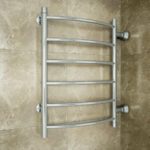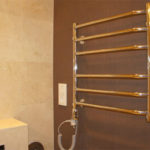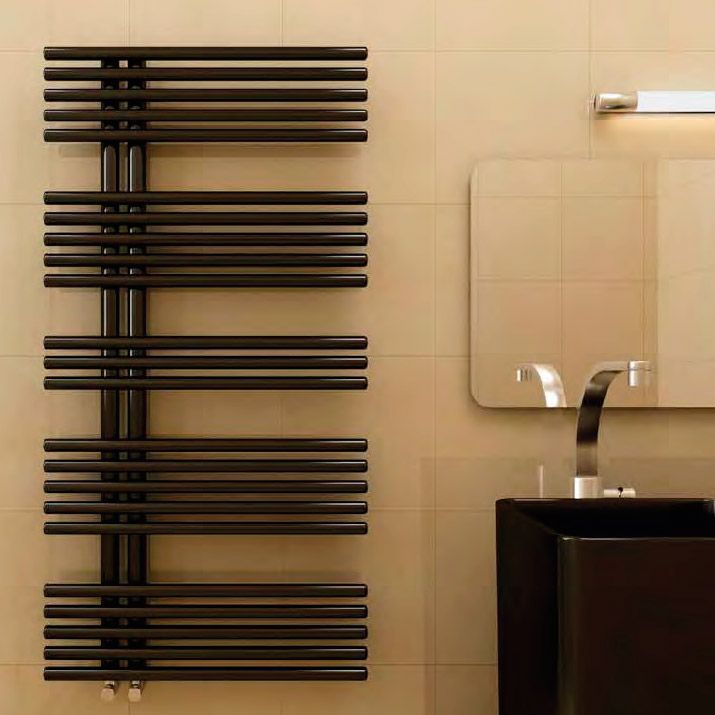Heated towel rail installation height
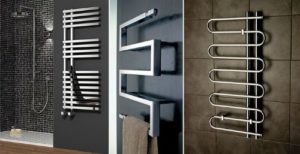 A bathroom without a heated towel rail looks incomplete. The presence of a household appliance allows you not only to dry a towel or linen, but also to maintain the required microclimate. The function of heating the room in winter and eliminating excess moisture in summer is assigned to this familiar object.
A bathroom without a heated towel rail looks incomplete. The presence of a household appliance allows you not only to dry a towel or linen, but also to maintain the required microclimate. The function of heating the room in winter and eliminating excess moisture in summer is assigned to this familiar object.
The content of the article
General rules for installing a heated towel rail
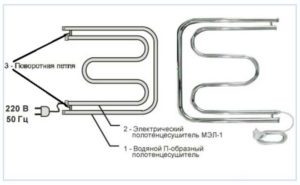 Rarely do you have to deal with the issue of the required installation height of household heating appliances. But, when replacing household appliances or carrying out repair work and installing new plumbing, you involuntarily think about installation standards and norms.
Rarely do you have to deal with the issue of the required installation height of household heating appliances. But, when replacing household appliances or carrying out repair work and installing new plumbing, you involuntarily think about installation standards and norms.
First, let's figure out what types and types of household equipment for towels there are. According to the method of work, they are distinguished:
- water;
- electrical;
- combined.
By external signs:
- M-shaped (regular coils);
- in the form of the letter S;
- ladder-like;
- U-shaped.
The specifics of the location of connected networks, wall mounting and connection methods force an individual approach to the issue of installing heated towel rails of various designs. In this case, the installation of plumbing fixtures must comply with generally accepted rules.
The important thing is that the equipment is connected to hot water supply or heating exactly as provided by the developer. If the plumbing fixture is located parallel to the hot water riser, then installation must be carried out using this method.
IMPORTANT! Under no circumstances should you modify the connection system for direct connection, especially with the installation of shut-off valves. This method grossly violates the rules for operating home networks and can lead to unforeseen circumstances!
When connecting to the heating system of apartment buildings, you cannot change the design features of the network to which the plumbing fixture is connected.
A common consideration when making connections is to maintain the installation method. This is done in the following ways:
- bottom (horizontal);
- vertical (straight);
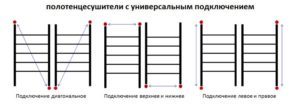
- diagonal.
Only carrying out repair work with replacing the internal wiring of networks and the lack of finishing coating on the walls will allow changing the connection method. Maintaining the center distance between connection pipes is of great importance.
ATTENTION! A slight adjustment of the size between the axes is possible if there is sufficient distance for the installation of several rotary corners, from the utility network to the plumbing fixture.
The desire to replace the usual M-shaped coil with a modern ladder will require serious alterations with the replacement of pipes and external finishing. Many consumers do not go as far as major reconstructions and leave the conversion of the vertical liner into a lower one, accessible for visual perception. This has a negative impact on the interior of the room, but makes the desired plumbing model available.
The generally accepted dimensions for connection are the dimensions of the connecting threads. Manufacturers usually equip plumbing fixtures with 1/2" inch internal threads, although there are exceptions.
The size of the heated towel rail is chosen depending on the size of the bathroom. The larger the room, the larger the device for drying towels.Fixation on the wall is carried out thanks to several supporting brackets, which are secured using quick installation or similar dowels with self-tapping screws.
IMPORTANT! Before installing a device for drying towels in an apartment building, it is necessary to coordinate the time of work with the servicing housing office. If necessary, write a written application for temporary disconnection of the required utility network! The exception is the presence of supply and return shut-off valves and shut-off valves without creating obstacles in the operation of the main line.
When replacing an old device with a new one, dismantling is carried out very carefully so as not to damage the threads of the connected pipes.
At what height should you hang a heated towel rail in the bathroom?
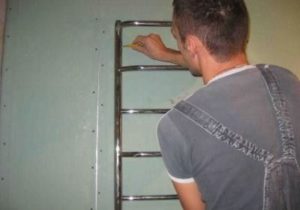 One of the generally accepted installation rules is to mount the device above the washing machine. And if it has a vertical loading, then the towel dryer should not interfere with the opening of the upper doors for loading and unloading laundry. It is difficult to classify such requirements as rules - they are rather recommendations for preserving space in familiar small bathrooms.
One of the generally accepted installation rules is to mount the device above the washing machine. And if it has a vertical loading, then the towel dryer should not interfere with the opening of the upper doors for loading and unloading laundry. It is difficult to classify such requirements as rules - they are rather recommendations for preserving space in familiar small bathrooms.
In accordance with the Construction Norms and Rules (SNiPs), the installation of internal sanitary fixtures is carried out at a height of at least 120 cm, if they are U-shaped. For M-shaped equipment, this minimum acceptable figure is 90 cm.
The rules provide for a desirable deviation from door frames and hanging furniture of at least 60 cm, but, in fact, this provision often has to be neglected. This is due to the small size of the premises. The height of the top part of the heated towel rail, in accordance with the standards, should not exceed 170 cm.This indicator is also not always possible to maintain, especially when using ladder-type devices.
After familiarizing yourself with the standard requirements, each user will wonder about the possibility of violating these standards for subjective reasons. The answer is very simple: the installation height of the plumbing fixture must correspond to the utility connections installed in the bathroom, not interfere with the use of other equipment and be convenient when used for drying towels and linen.
Another factor that affects the height is whether it matches the bathroom interior. It is especially important, when carrying out repairs with replacement of interior decoration, to combine the installation height of the heated towel rail with pronounced decor lines, as well as with other plumbing fixtures.
After reviewing the above material, everyone can safely determine the location and required height of plumbing equipment.

